
The Defence of Cripple Creek Ford, 1759
20th October 2024, 0 Comments
The French & Indian Wars, Rebels and Patriots, 28mm
This game used a scenario straight from the rule book, (Scenario G) which revolves around a river and a bridge. One side – the slightly larger force – wanted to cross it, and the other lot wanted to stop them. In this game, I played the British defenders, while Jim commanded the French and Indians intent on forcing their way over the creek, cross-able only at the ford. I decided against a bridge, as this was set in the backwoods of up-state New York. 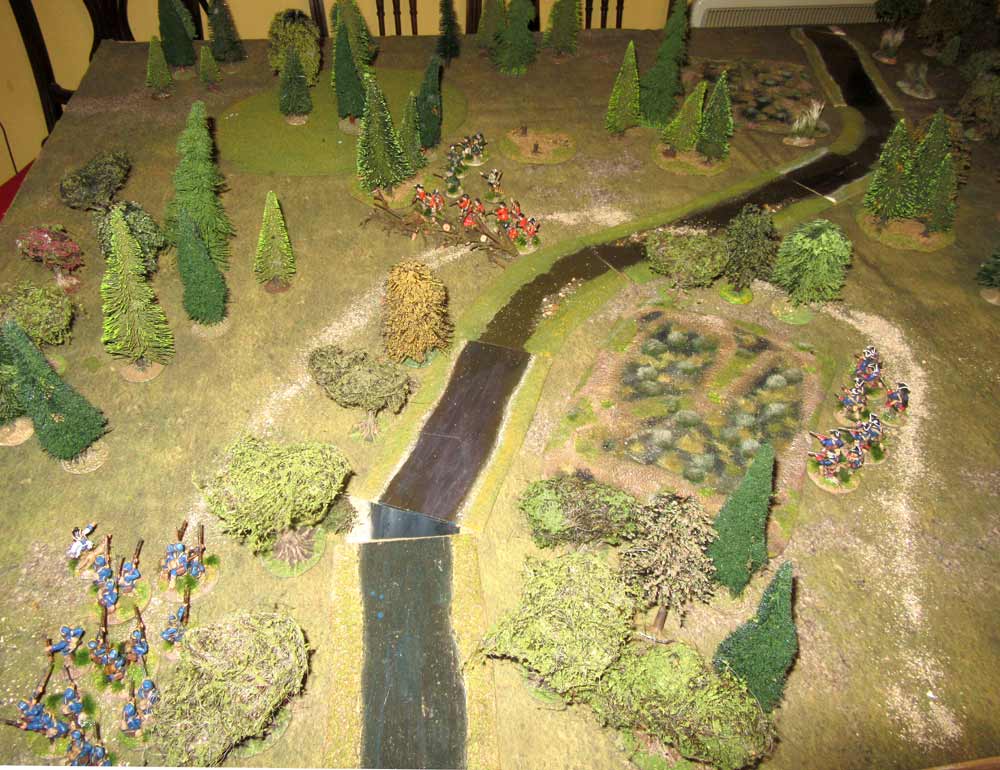 The British had a small force on the French side of the bridge, with a makeshift breastwork thrown up across the track to give them cover. The rest of the British force – some colonial troops from the New York regiment and a few Rangers, were on the eastern, or British side of Cripple Creek. The French appeared on the western side, advancing along the track leading to the ford. the game, by the way, was fought on a wood-covered 6×4 foot table.
The British had a small force on the French side of the bridge, with a makeshift breastwork thrown up across the track to give them cover. The rest of the British force – some colonial troops from the New York regiment and a few Rangers, were on the eastern, or British side of Cripple Creek. The French appeared on the western side, advancing along the track leading to the ford. the game, by the way, was fought on a wood-covered 6×4 foot table.  The French advance was led by two units of Companies de la Marine, in their blue waistcoats, followed by two more units of veteran Quebecois militia. The British defenders – a unit of light infantry supported by a small unit of Rangers – would have their work cut out to stop this lot. As if that wasn’t enough, two war parties of Abenaki were approaching from the western edge, along with a small unit of sharpshooting Coureurs de Bois.
The French advance was led by two units of Companies de la Marine, in their blue waistcoats, followed by two more units of veteran Quebecois militia. The British defenders – a unit of light infantry supported by a small unit of Rangers – would have their work cut out to stop this lot. As if that wasn’t enough, two war parties of Abenaki were approaching from the western edge, along with a small unit of sharpshooting Coureurs de Bois. 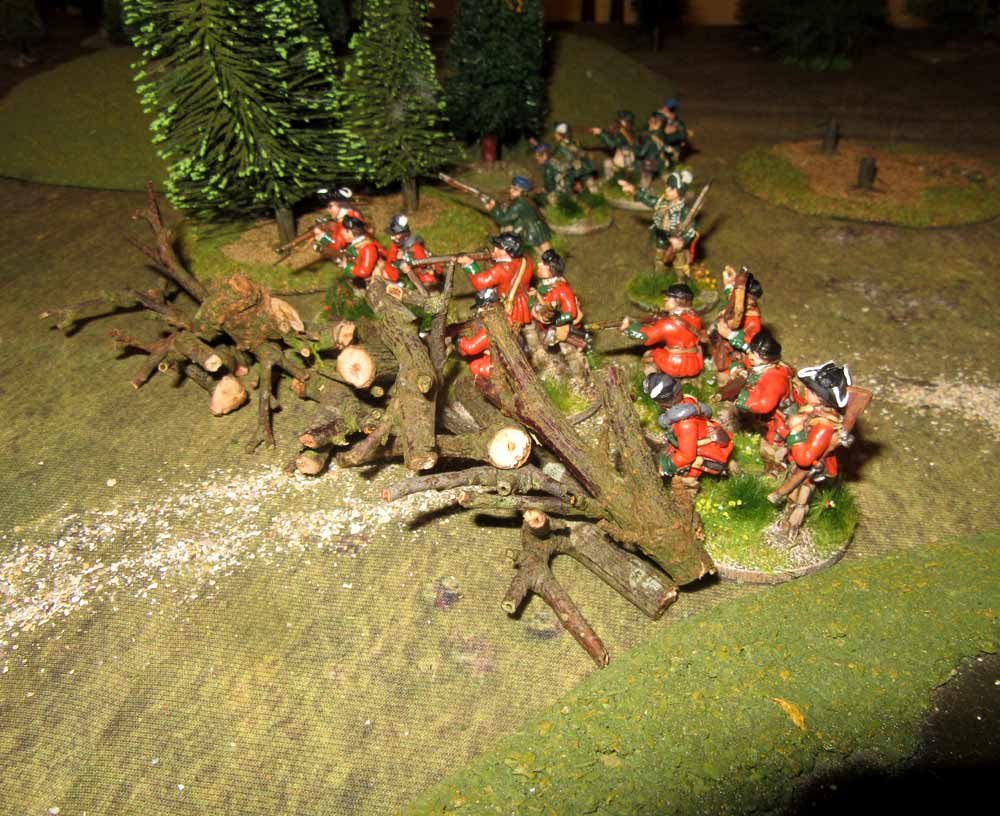 The British defenders though, held their fire until the French drew closer. However, as the French leading units neared the barricade they came under fore from their right flank – a unit of New York which was stationed on the east bank of the river. A couple of Marines dropped, but that didn’t stop the advance, and when they got within range the French opened up on the defenders, and then charged forward. That was when the British light infantry opened fire.
The British defenders though, held their fire until the French drew closer. However, as the French leading units neared the barricade they came under fore from their right flank – a unit of New York which was stationed on the east bank of the river. A couple of Marines dropped, but that didn’t stop the advance, and when they got within range the French opened up on the defenders, and then charged forward. That was when the British light infantry opened fire. Their first volley was very effective, dropping four of the already weakened leading unit of Marines, and sending them retreating back into the nearby trees. The second unit of Marines though, stayed where they were, and after firing they threw themselves against the defenders and their log barricade. While this was going on the two Abenaki units appeared, and the French backwoodsmen, who began sniping at the Rangers as the Abenaki advanced.
Their first volley was very effective, dropping four of the already weakened leading unit of Marines, and sending them retreating back into the nearby trees. The second unit of Marines though, stayed where they were, and after firing they threw themselves against the defenders and their log barricade. While this was going on the two Abenaki units appeared, and the French backwoodsmen, who began sniping at the Rangers as the Abenaki advanced. 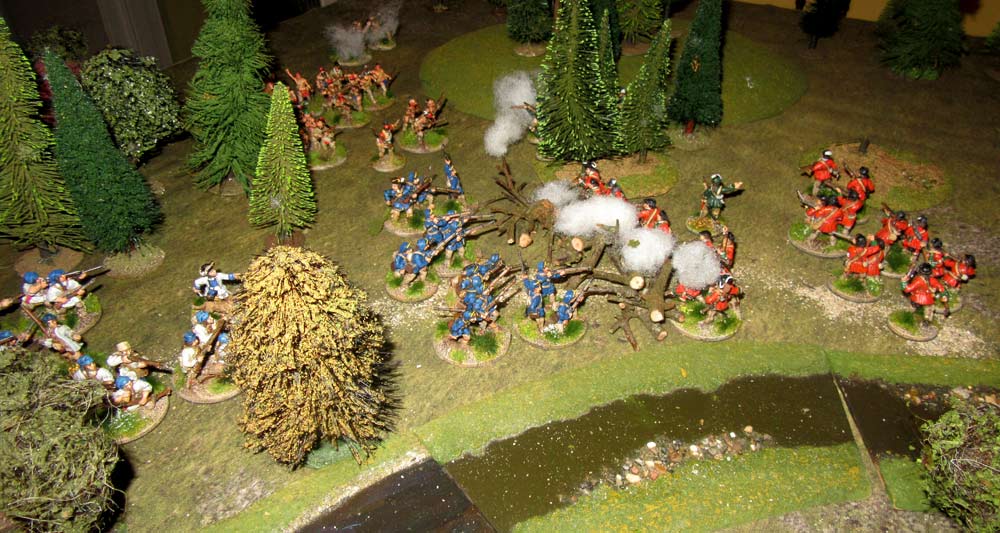 Over at the log breastwork the remaining Companie de la Marine unit charged in, but in the brief melee that followed over the breastworks, it was the British who had the best of the fight. So, the second blue-coated unit withdrew into the trees, to lick its wounds, while the Quebec militia opened up on the now fairly depleted defenders. The real threat now, was coming from the west, as the Abenaki got within charge reach of the small Rangers unit.
Over at the log breastwork the remaining Companie de la Marine unit charged in, but in the brief melee that followed over the breastworks, it was the British who had the best of the fight. So, the second blue-coated unit withdrew into the trees, to lick its wounds, while the Quebec militia opened up on the now fairly depleted defenders. The real threat now, was coming from the west, as the Abenaki got within charge reach of the small Rangers unit.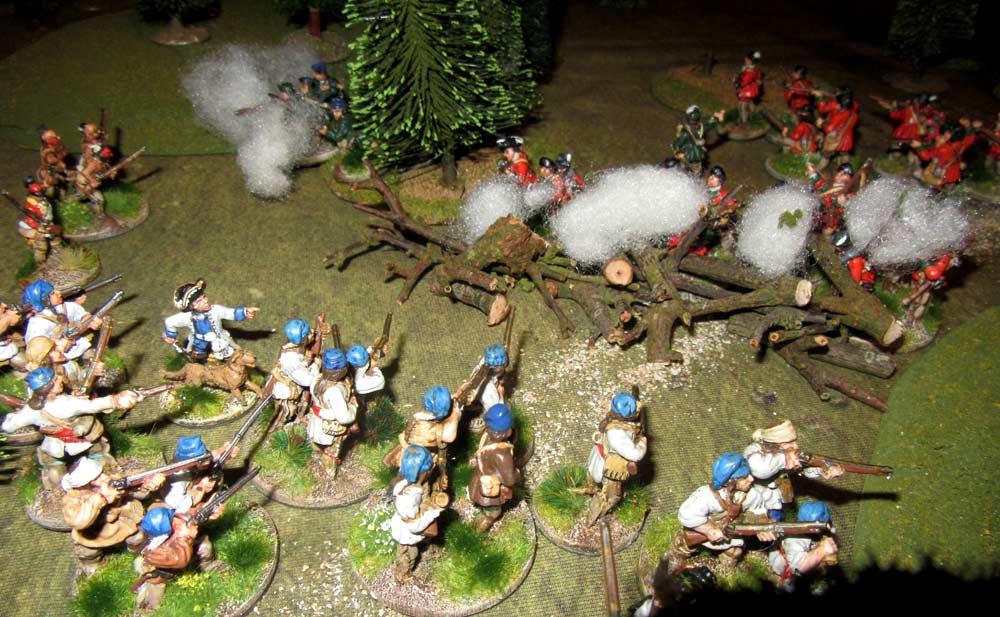 By then though, the British were able to call for reinforcements from the other side of the creek. A second light infantry unit crossed the ford first, and was directed round the back of the defences, to support the heavily-outnumbered Rangers. They certainly needed all the help they could get.
By then though, the British were able to call for reinforcements from the other side of the creek. A second light infantry unit crossed the ford first, and was directed round the back of the defences, to support the heavily-outnumbered Rangers. They certainly needed all the help they could get.
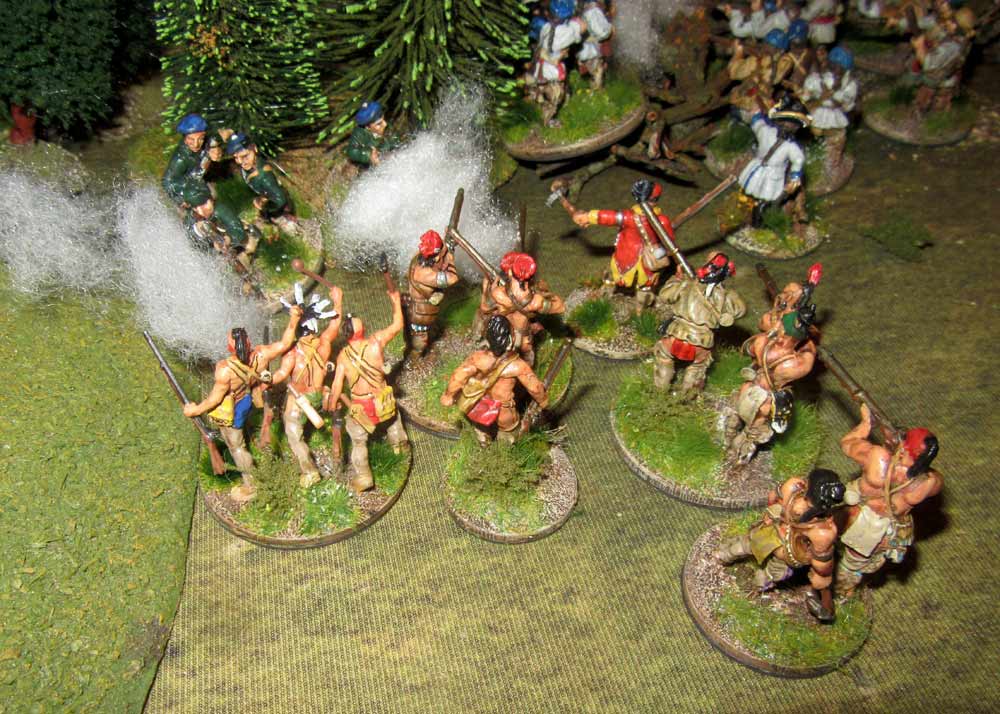 It was at that moment that the Abenaki charged in – two units against a single small unit. Both sides had taken casualties though – a couple of Rangers were down, and five Abenaki. The melee though, only allowed one unit to get to grips with the defenders, who amazingly held their ground.
It was at that moment that the Abenaki charged in – two units against a single small unit. Both sides had taken casualties though – a couple of Rangers were down, and five Abenaki. The melee though, only allowed one unit to get to grips with the defenders, who amazingly held their ground.  At that moment, that second unit of light infantry appeared on the left flank of the Abenaki, at the top of a slight rise, and they then charged down into the ranks of the warriors. This turned the tide, and soon both Abenaki units withdrew to lick their wounds. The Rangers though, were down to just two men.
At that moment, that second unit of light infantry appeared on the left flank of the Abenaki, at the top of a slight rise, and they then charged down into the ranks of the warriors. This turned the tide, and soon both Abenaki units withdrew to lick their wounds. The Rangers though, were down to just two men.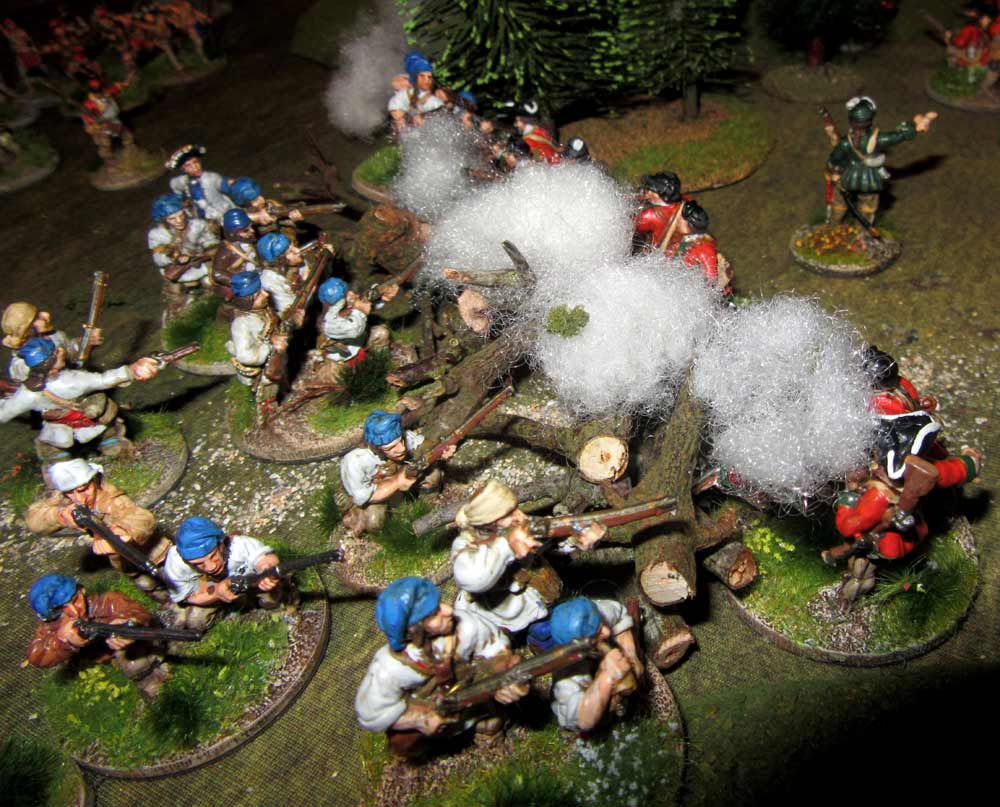 Meanwhile, over at the log barricade, the Quebec militia stormed in, and clambered over the logs to get at the remaining British light infantry. This time numbers told, and the British light infantry were forced to withdraw, and the Quebec militia scrambled over the barricade.
Meanwhile, over at the log barricade, the Quebec militia stormed in, and clambered over the logs to get at the remaining British light infantry. This time numbers told, and the British light infantry were forced to withdraw, and the Quebec militia scrambled over the barricade. 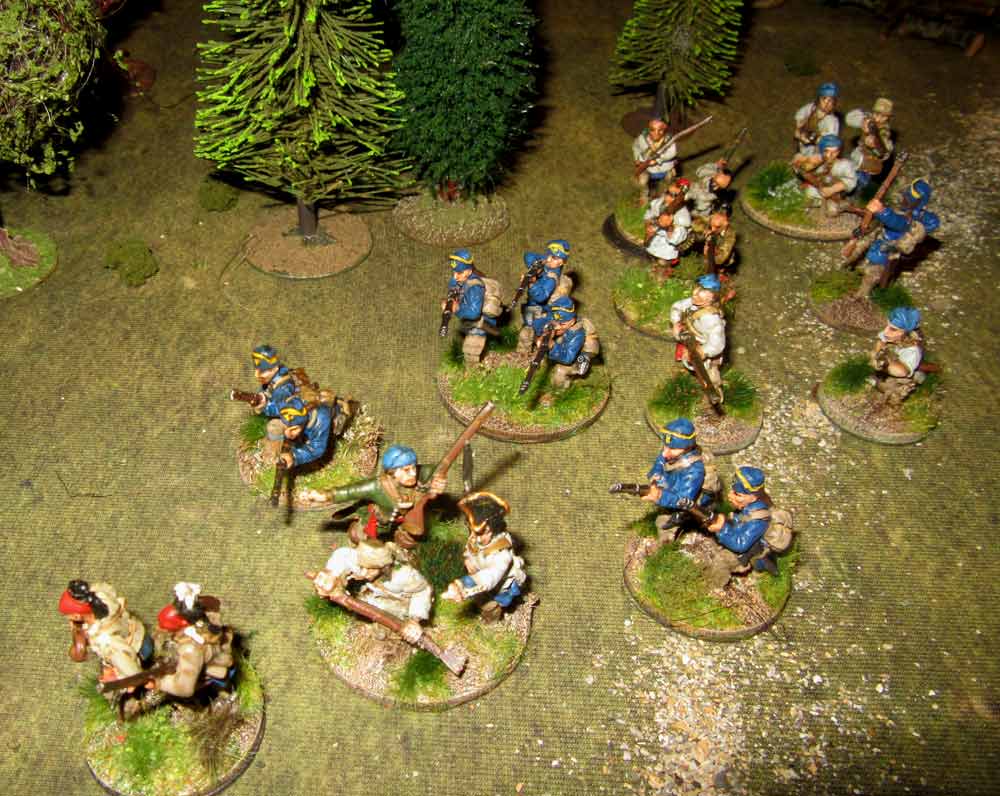 Then, they were met by a close-range volley from British reinforcements – the unit of colonial New York troops that acted as the British reserve. it had crossed the stream behind the light infantry, and it was in place to fire into the attackers as they crossed the barricade, halting the victorious French in their tracks.
Then, they were met by a close-range volley from British reinforcements – the unit of colonial New York troops that acted as the British reserve. it had crossed the stream behind the light infantry, and it was in place to fire into the attackers as they crossed the barricade, halting the victorious French in their tracks.  The French ran, allowing the New Yorkers to reclaim the barricade and fire into the fleeing enemy ranks. That was it – the French attack had been beaten off with aplomb. It was a great little fight – and a fairly bloody one, and it could easily have gone the other way. Fortune favoured Britannia that day!
The French ran, allowing the New Yorkers to reclaim the barricade and fire into the fleeing enemy ranks. That was it – the French attack had been beaten off with aplomb. It was a great little fight – and a fairly bloody one, and it could easily have gone the other way. Fortune favoured Britannia that day!

